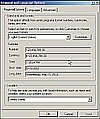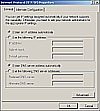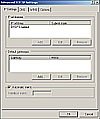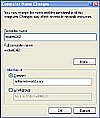The process to perform a clean installation of Windows XP Professional is easy to carry out and will require 30–90 minutes of time, depending on your particular hardware. The Setup process consists of several steps which fall into two phases: the text-mode phase and the GUI-mode phase.
To perform a clean installation of Windows XP Professional, follow the process outlined here.
NOTE
For more information on customizing an installation using Setup switches, see the section "Using Installation Switches," later in this chapter.
-
Power on your computer and insert the Windows XP Professional Setup CD-ROM into the CD drive. If your computer is not capable of booting from the CD drive, you will need to create and use the Windows XP Professional Setup floppy disks.
-
When prompted onscreen, press any key (or the specific key required) to boot the computer from the CD-ROM.
-
After Setup briefly examines your computer's hardware, you will be prompted to press F6 if you have any third-party drivers that require loading, such as RAID device drivers.
-
At the next screen, you will be prompted to press F2 if you are performing an Automated System Recovery (ASR). Just sit on your hands and let Setup do its thing here.
-
For the next few minutes, Setup will load the files required to perform the installation. If you have an older, slower computer, this is a good time to grab a cup of coffee!
-
When you are presented with the Welcome to Setup screen as shown in Figure 3.1, press Enter to continue on with the setup process.
-
Before you can install Windows XP Professional, you must accept the End-User License Agreement. Press F8 to accept the EULA and continue forward with the installation process.
-
From the screen shown in Figure 3.2, you can create and delete partitions on your hard drives. Additionally, you will need to select the partition that you will install Windows XP Professional on. After selecting the partition to install Windows XP Professional on, press Enter to continue on.
-
On the screen shown in Figure 3.3, you will need to select what file system to format the selected partition with. If you are installing on a partition that was previously formatted with FAT16 or FAT32, options to convert the file system will also be present. In most clean installations, the NTFS file system is preferable, so consider using it. After making your file system selection, press Enter to continue on.
-
After the formatting process is complete (see Figure 3.4), Setup will examine your hard drives and then progress to copying the required installation files.
-
After the files have been copied from the installation source to their correct locations on the hard drive, the installation must be initialized.
-
After initialization has completed, the computer will prompt you for a restart. This is the last step of the text-mode phase. If you are prompted to "hit any key" to boot from your CD-ROM on the subsequent startup, do not do so; your installation will continue from the hard drive.
-
After the computer restarts, you will be presented with the GUI phase of Setup, as shown in Figure 3.5. Your screen may flash or go blank several times during the GUI phase—this is normal.
-
After some time (and after the small progress bar at the bottom-left side of the screen moves to 100%), you will be presented with your first configuration opportunity: the Regional and Language Options page. In most cases, you will want to simply click Next to accept the default values. Should you need to perform a custom configuration, you can change many settings, such as numbers, dates, and currencies, as shown in Figure 3.6, or Text Input Languages and keyboard layouts. When you have finished with your selections, click Next to continue.
-
From the Personalize Your Software page, you can enter your name and organization. At a minimum, you must enter a name. You cannot use the name "Guest" or "Administrator." You do not have to enter an organization. After entering your information, click Next to continue on.
-
From the Your Product Key page, enter your 25-digit CD key. Click Next to continue on after entering your CD key.
-
From the Computer Name and Administrator Password page, shown in Figure 3.7, you will need to enter a unique computer name (that is, no other device on the network should have the same name) and the Administrator password. After entering this information, click Next to move ahead.
-
From the Date and Time Settings page, configure the appropriate date, time, and time zone settings. If you are in a Daylight Savings area, be sure to place a check in the Automatically Adjust Clock for Daylight Savings Changes box. Click Next to continue.
-
After Windows XP Professional Setup performs some more work, you will be presented with the Network Settings page, as shown in Figure 3.8. If this computer is participating in a domain-based network with DNS servers, DHCP servers, and/or WINS servers, you will want to select the Custom Settings radio button. If you are setting up this computer to participate in a workgroup or as a standalone computer, you can pretty much rest safely with the default selection of Typical settings. Either way, click Next to move on.
-
If you selected the Custom Settings option in Step 19, you will be presented with the Networking Components page. From here you can install, uninstall, and configure protocols, services, and clients. Since most configuration centers around the TCP/IP protocol, we will look at that. Selecting Internet Protocol (TCP/IP) and clicking Configure will open the Internet Protocol (TCP/IP) Properties page shown in Figure 3.9. Clicking the Advanced button opens the Advanced TCP/IP Settings page, shown in Figure 3.10, which lets you specify many TCP/IP related settings, including DNS servers, DNS suffixes, WINS servers, NetBIOS over TCP/IP, and TCP/IP filtering among other settings. After you've made your advanced configuration, click OK to close the Advanced TCP/IP Settings page. Click OK to close the Internet Protocol (TCP/IP) Properties page and then click Next after making all configuration entries. (You can change network properties at any time after installation completes, should you need to, so you needn't worry about it now.)
-
From the Workgroup or Domain page (see Figure 3.11), you will need to supply either the workgroup name or domain name you will be placing this computer into. If you are installing a standalone computer, you can pick any name you want for the workgroup. If you are installing a computer in a workgroup, ensure you enter the correct workgroup name. Either way, you will want to select the No option. If you want to join the computer to a domain at this time, you will need to supply the user name and password of a user who has privileges to add computers to the domain. You can also add the computer to a domain after installation is complete (which is what we will do later). Whatever your selection is, click Next to continue on.
-
Windows Setup performs more configuring and file copying at this point, including installing the Start menu, registering components, saving settings, and lastly, removing temporary files. After Setup completes this phase, the computer restarts once again.
-
After the restart, the Windows XP Professional splash screen appears while Setup completes the installation process.
-
On the Welcome to Microsoft Windows page, click Next to get down to the last stages of Setup.
-
After Windows quickly checks your Internet connectivity status, it progresses to the Will This Computer Connect to the Internet Directly or Through a Network page. If you are using a modem for a dial-up Internet connection, you will most likely want to select the No, This Computer Will Connect Directly to the Internet option. If you are part of a network, then you should select the Yes, This Computer Will Connect Through a Local Area Network or Home Network option. Click Next after making your selection to continue on. (Here, we will select the Yes option.)
-
From the Ready to Activate Windows? page, seen in Figure 3.12, you will need to decide whether or not you are going to activate your installation at this time via the Internet. This is the easiest option by far, and thus the option we will use here. For more information on Product Activation, see the "Product Activation" section, later in this chapter. After making your selection, click Next to continue on. If you will not be activating at this time, skip to Step 28.
-
From the Ready to register with Microsoft page, select either to register or not register your Windows XP Professional software. You do not have to register your software to perform Product Activation. After making your selection, click Next to continue on.
-
After activation completes, you will be presented with the Who Will Use This Computer? page. Enter at least one user account, as shown in Figure 3.13, and click Next to continue on.
-
When all is said and done you will receive a Thank You! page informing you of what has been accomplished, such as installing Windows XP Professional, activating it, and so on. You've just completed the installation of Windows XP Professional! Click Finish to complete the process.
-
After a few moments of disk activity, the first user you configured in Step 28 will be logged in to the computer. At this time, you need to configure a strong password for this user account since the password box is empty. Do this before doing anything else. The password can most easily be changed by using the User Accounts applet located in the Control Panel. To change the password from the User Accounts applet, simply select the user and choose Create a Password.
-
Is at least seven characters long. The most secure passwords are those that are between seven and fourteen characters long.
-
Contains characters from each of the following three groups: letters (A, B, C...a, b, c), numbers (0, 1 ,2), and symbols (!, #, %, and so on).
-
Has at least one symbol character in the second through sixth positions.
-
Is significantly different from prior passwords.
-
Does not contain your name or user name.
-
Is not a common word or name, such as family or pet names.
-
Does not contain your address, phone number, license plate number, or any other common knowledge item.
-
At this point, you are done. You can go on to add the computer to a domain, as detailed in Step 32, or stop here...the choice is up to you.
-
From the System applet in the Control Panel, switch to the Computer Name tab. Click the Change button to bring up the Computer Name Changes page, as shown in Figure 3.14. From here you can change the computer name and workgroup or domain membership. Enter the domain name information and click OK. You will need to supply the username and password for an account that is authorized to add computers to the domain. The username should be in the user@domain.com format. After you have joined the domain, a restart will be required to complete the process.
Making and Using Setup Floppy Disks
If you have a computer that does not support booting from the CD-ROM (that is, it does not support the El Torito specifications), then you will need to create and use a set of Windows XP Professional Setup floppy disks.
To download the executable to create the disks, see MSKB# Q310994 located at http://support.microsoft.com/default.aspx?scid=kb;EN-US;q310994.
For more information on the El Torito specification, see http://www.netserverworld.com/infocenter/files/eltorito.pdf.
 Figure
3.1 Welcome to Setup.
Figure
3.1 Welcome to Setup.
 Figure
3.2 Selecting the installation partition.
Figure
3.2 Selecting the installation partition.
MBR Versus GPT
MBR (Master Boot Record) and GPT (Globally Unique Identifier Partition Table) refer to types of hard disk arrangement. The MBR method is the old standby...it's been around since the days of old. The GPT method is new to Windows with the 64-bit edition of Windows XP Professional. Chapter 25, "Managing Your Hard Disks," discusses GPT disks at length, as does the TechNet article located at http://www.microsoft.com/technet/prodtechnol/winxppro/reskit/prkb_cnc_ywwc.asp.
 Figure
3.3 Selecting a file system.
Figure
3.3 Selecting a file system.
 Figure
3.4 Formatting the partition.
Figure
3.4 Formatting the partition.
 Figure
3.5 The GUI phase of Setup begins.
Figure
3.5 The GUI phase of Setup begins.
 Figure
3.6 Configuring standards and formats.
Figure
3.6 Configuring standards and formats.
 Figure
3.7 Configuring the computer name and administrative password.
Figure
3.7 Configuring the computer name and administrative password.
 Figure
3.8 Configuring the network settings.
Figure
3.8 Configuring the network settings.
Alternate Configuration
New in Windows XP Professional, the Alternate Configuration tab of the Internet Protocol (TCP/IP) Properties page enables you to configure an alternate (secondary) TCP/IP setup for those times when a DHCP server is not found. This is a great benefit to portable computer users who would like their portable computer to default to a second set of preconfigured TCP/IP settings when not connected to the corporate network.
 Figure
3.9 The Internet Protocol (TCP/IP) Properties page.
Figure
3.9 The Internet Protocol (TCP/IP) Properties page.
 Figure
3.10 The Advanced TCP/IP Settings page.
Figure
3.10 The Advanced TCP/IP Settings page.
 Figure
3.11 The Workgroup or Domain page.
Figure
3.11 The Workgroup or Domain page.
 Figure
3.12 Preparing to activate Windows XP.
Figure
3.12 Preparing to activate Windows XP.
 Figure
3.13 Configuring a user account.
Figure
3.13 Configuring a user account.
What Makes a Strong Password?
According to Microsoft, a strong password is one that has the following characteristics:
 Figure
3.14 Joining a domain.
Figure
3.14 Joining a domain.